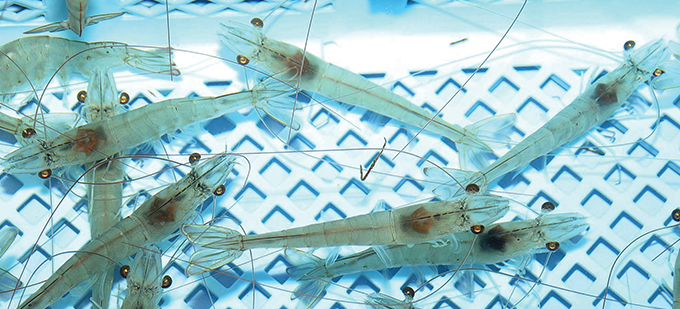Home > Highlighting JAPAN >Highlighting Japan July 2015>Fishing for Flavor
Highlighting JAPAN

Fishing for Flavor
Shrimp Go Under Cover to Combat Food Insecurity
Designed to provide a safe, high-quality source of nutrition, Japan’s first indoor shrimp production system (ISPS) sprang from an urge to solve the world’s food security problems as the nation develops technology for the indoor mass breeding of marine organisms on land.

In conjunction with a joint program within industry, academia and national research institutes, IMT Engineering, Inc.—a company in Myoko, Niigata Prefecture that raises and sells shrimp—has been engaged in much-watched experiments to develop Japan’s first indoor shrimp production system (ISPS), enabling the cultivation of shrimp on land, away from their natural ocean and river habitats.
Shrimp are in high demand globally, but 90 percent of those distributed worldwide are farmed, and shrimp cultivation presents a host of issues. In places such as Southeast Asia, Africa and South America, for example, the general procedure is to cut down coastal mangrove forests to create shrimp ponds. To raise productivity, the shrimp are given massive amounts of hormones. And as shrimp waste and leftover feed settle to the bottom of the ponds, the waters become contaminated if neglected. Humectants and preservatives are added in an attempt to mask the water quality, and disease-prevention measures such as antibiotics are used as well.
That all results in drug-dependent shrimp and massive marine pollution. Shrimp farms must therefore be relocated every four to five years.Through the overfishing of natural species, harvests are also in severe decline, and coupled with foreign exchange risk that causes steep price increases, the overall supply of shrimp is unstable.
The ISPS is housed inside a plant, making it impervious to climate changes, and uses microorganisms to cleanse and circulate the water, promoting growth in a renewable system. The process has eliminated the need for drugs and antibiotics, producing shrimp that are both safe and high in quality. Since the birth and growth of the shrimp is completely controlled and monitored, the system even provides the opportunity to retroactively investigate and authenticate conditions all the way back to a shrimp’s birth. “These are the only shrimp in this country which possess perfect traceability,” explains IMT Engineering president and representative director Yukishi Tomita proudly.
Instead of choosing a species that would burrow into the mud, IMT selected whiteleg shrimp because of their penchant for swimming. Sterile, healthy, juvenile whitelegs are given high-quality feed and allowed to swim and grow in clean, circulating pools of water, leading to the production of delicious, high-quality shrimp with firm bodies. Because there are no ill effects from mud or bacteria, they also have none of the smell peculiar to seafood, can be eaten raw after a single freezing, and after cooking can be consumed from head to tail, shell and all. This system has low environmental impact yet doubles the productivity of traditional methods while still achieving the desired taste and quality.
IMT’s Tomita actually had a long career in the field of international development, and has been involved in ODA projects in emerging nations as well. Aware of the issues of an exploding population and food security, and believing that the food problem is an urgent issue for humanity, he became captivated by the possibilities the ISPS presented—impervious to climate change and able to provide high-quality protein under any geographical conditions.
After incorporating this technology, IMT’s first domestic production and marketing sample was the “Myoko Yuki” shrimp. In a plant built in a high plains town far from the ocean, these shrimp were thoroughly monitored via information and communications technology from birth to distribution and sales. They instantly became popular for their delicious taste and safety qualities, with orders coming in from famous Italian eateries in Tokyo and Japanese branches of renowned New York delicatessens, and they are continually sold out on their customized e-commerce site. The shrimp were even supplied to local Niigata schools to serve in school lunches. In the glow of the success of this example of regional revitalization, Tomita says, “Theoretically, the ISPS is an unadulterated blessing. It’s only a matter of time before it becomes widespread.”
In March 2015, an ISPS plant was constructed in the landlocked country of Mongolia in its capital of Ulan Bator, launching a new phase of shrimp production with an eye toward development throughout Asia. With business collaborations and international development plans progressing behind the scenes, the company has been receiving a flood of inquiries.
“Contributing to a safe, secure and stable supply of food, not just to Japan but also to all people around the world,” is IMT Engineering’s guiding precept. With that in mind, Tomita declares, “This is the year our abilities will be tested.” With its groundbreaking technology enabling even landlocked nations to develop marine farming, the company is drawing attention from the world over.
© 2009 Cabinet Office, Government of Japan






